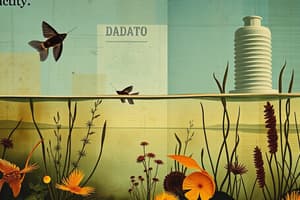Podcast
Questions and Answers
Which of the following landform features is primarily associated with coastal erosion processes?
Which of the following landform features is primarily associated with coastal erosion processes?
- Dune
- Fjord (correct)
- Tombolo
- Barrier Island
How do winter conditions typically affect sandy shorelines compared to summer conditions?
How do winter conditions typically affect sandy shorelines compared to summer conditions?
- Increased erosion and steeper slopes (correct)
- Increased deposition and gentler wave action
- Lower water levels and less intense storms
- Decreased erosion and steeper slopes
Which coastal landform acts as a natural buffer to protect inland areas from storm wave impacts?
Which coastal landform acts as a natural buffer to protect inland areas from storm wave impacts?
- Dune (correct)
- Beach
- Barrier Spit
- Tombolo
What primary characteristic defines sandy shore landforms?
What primary characteristic defines sandy shore landforms?
Which of the following features connects an offshore island to the mainland?
Which of the following features connects an offshore island to the mainland?
How does the presence of well-developed berms typically correlate with seasonal changes on a beach?
How does the presence of well-developed berms typically correlate with seasonal changes on a beach?
In which scenario would you expect the most significant beach erosion?
In which scenario would you expect the most significant beach erosion?
What distinguishes a barrier spit from a barrier island?
What distinguishes a barrier spit from a barrier island?
Which factor primarily determines whether a coastal area experiences more deposition or erosion?
Which factor primarily determines whether a coastal area experiences more deposition or erosion?
Which of the following coastal features is least likely to be associated with sandy shore landforms?
Which of the following coastal features is least likely to be associated with sandy shore landforms?
A coastal area is experiencing significant land subsidence due to increased groundwater extraction. Over time, what primary coast feature is most likely to develop as a result?
A coastal area is experiencing significant land subsidence due to increased groundwater extraction. Over time, what primary coast feature is most likely to develop as a result?
Which of the following scenarios would most likely result in the formation of a primary coast?
Which of the following scenarios would most likely result in the formation of a primary coast?
A coastal region is characterized by a series of elongated ridges of sand running parallel to the shoreline, providing protection to the mainland. These features are most likely classified as:
A coastal region is characterized by a series of elongated ridges of sand running parallel to the shoreline, providing protection to the mainland. These features are most likely classified as:
What is the primary difference between a primary and secondary coast?
What is the primary difference between a primary and secondary coast?
A location is noted to have significant constructive wave activity causing sediment to be deposited. Which of the following is most likely to occur?
A location is noted to have significant constructive wave activity causing sediment to be deposited. Which of the following is most likely to occur?
Which set of characteristics would be most indicative of a rocky coast landform?
Which set of characteristics would be most indicative of a rocky coast landform?
A tidewater glacier is retreating due to climate change. What is the most likely immediate impact on the adjacent coastline?
A tidewater glacier is retreating due to climate change. What is the most likely immediate impact on the adjacent coastline?
What is the main factor that differentiates a sea cave from a sea arch?
What is the main factor that differentiates a sea cave from a sea arch?
A river carries a substantial amount of sediment to the coast. Over time, which coastal feature is most likely to form at the river's mouth?
A river carries a substantial amount of sediment to the coast. Over time, which coastal feature is most likely to form at the river's mouth?
In an area with significant marine life, which secondary coast feature is likely to develop?
In an area with significant marine life, which secondary coast feature is likely to develop?
Flashcards
Coast
Coast
Land or area next to the ocean.
Primary Coasts
Primary Coasts
Coasts formed primarily by land-based processes like erosion and tectonic activity.
Secondary Coasts
Secondary Coasts
Coasts shaped by ocean-based processes like wave erosion and marine life.
Delta
Delta
Signup and view all the flashcards
Drowned River Valley
Drowned River Valley
Signup and view all the flashcards
Reef
Reef
Signup and view all the flashcards
Coastal Deposition
Coastal Deposition
Signup and view all the flashcards
Coastal Erosion
Coastal Erosion
Signup and view all the flashcards
Fjord
Fjord
Signup and view all the flashcards
Sea Arch
Sea Arch
Signup and view all the flashcards
Headland
Headland
Signup and view all the flashcards
Sea Caves
Sea Caves
Signup and view all the flashcards
Sea Cliff
Sea Cliff
Signup and view all the flashcards
Tidewater Glacier
Tidewater Glacier
Signup and view all the flashcards
Barrier Island
Barrier Island
Signup and view all the flashcards
Barrier Spit
Barrier Spit
Signup and view all the flashcards
Dune
Dune
Signup and view all the flashcards
Tombolo
Tombolo
Signup and view all the flashcards
Study Notes
- A coast is the land or area next to the ocean (seashore)
- Marine coasts, also called the seashore, are dynamic regions that constantly change
- Marine coasts are classified into primary and secondary coasts
Primary Coasts
- Formed by land-based processes
- Can include: erosion, sediment deposition, tectonic activity (earthquakes, volcanoes), and sea level changes
- Delta: deposit of sand and soil at a river's mouth
- Drowned River Valley: eroded by water or glaciers
- Fault Coast: created by tectonic movement in the Earth's crust
- Lava Coast: formed by volcanic eruptions
Secondary Coasts
- Formed by ocean-based processes
- Include wave erosion, water chemistry, and marine life
- Reef: ridge of rock, sand, or coral rising toward the water's surface (e.g., Great Barrier Reef)
- Mangrove Swamp: tropical evergreens growing along tidal shores with above-ground roots
- Salt Marsh: marshy grassland often flooded by seawater
- Sea Stacks: durable coastal formations left after erosion removes loose sediment
Primary Coast Features
- Shaped by land-driven processes
- Include: volcanic activity, earthquake activity, land-driven processes and sea level rise
- Other features: glacier erosion, drowned river mouths, deltas, estuaries, and mangrove swamps
Secondary Coast Features
- Shaped by ocean-driven processes
- Include: sea stacks, barrier islands, kelp forests and sand bars
- Other features: coral reefs, sand spits, ocean-driven processes, salt marshes, and wave erosion
Landform Processes
- Coastal deposition occurs when material being transported is dropped by constructive waves
- Coastal erosion is the process by which coastal waters wear or tear down soil, rocks, and sand along the coast
Rocky Coast Characteristics
- High energy and high erosion
- All types of rocks, faults, folds, and igneous intrusions are present
- They have a resistant bedrock profile, high-energy winds and waves
Rocky Coast Landforms
- Fjords: Glaciers carved deep valleys that were eventually filled with seawater
- Headlands: small beaches that are isolated with little to no exchange of sediment (capes)
- Sea Caves: large, hollow chambers caused by sea erosion from waves
- Sea Arches: natural bridge or rock formation caused when waves wear away the bottom of a rock
- Sea Cliffs: steep faces of rock and soil formed by destructive waves
- Tidewater Glacier: glacier that descends into the sea and typically forms icebergs
Sandy Shore Landforms
- Characterized by low energy and high deposition
- They feature highly complex landforms that experience constant change due to wave action and sediment transport
- Sandy shores are obstacles to wave activity
More Sandy Shore Landforms
- Barrier Island: constantly changing deposit of sand that forms parallel to the coast
- Barrier Spit: narrow strips of sandy landforms connected to the mainland but stretching out into the sea
- Beach: narrow strip of land separating a body of water from inland areas, made up of tiny rocks and minerals
- Dune: ridge or hill of loose sand that acts as a buffer from the effects of storm waves
- Tombolo: piece of land or sand that connects a previous island to the mainland
Summer Coastal Landforms
- Well-developed berms
- Higher water maintained and gently sloped
- Typically calmer waves
Winter Coastal Landforms
- May or may not have a berm
- Lower water that is steep-sloped
- Characterized by intense waves
Summer vs. Winter Causes
- There is potentially less erosion and calmer waters in Summer than in Winter
- Conversely, there is potentially more erosion and intense waters in Winter than in Summer
- There is more deposition and lower energy in the Summer in comparison to Winter
- There is less deposition and higher energy in the winter compared to Summer
Seasons
- Summers typically have less intense storms and therefore smaller waves
- Winters typically have more intense storms and therefore larger waves
Studying That Suits You
Use AI to generate personalized quizzes and flashcards to suit your learning preferences.




